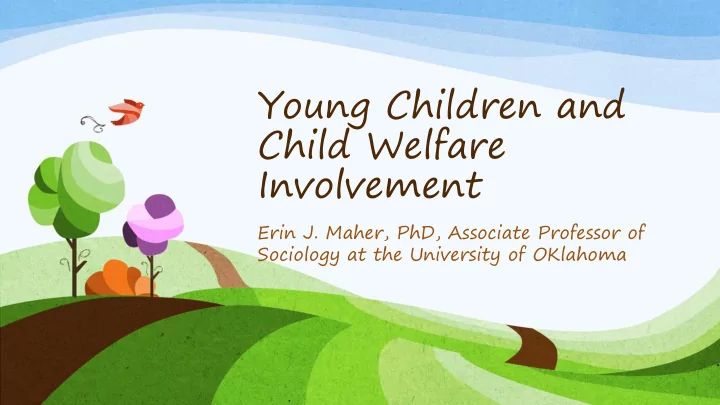

Young Children and Child Welfare Involvement Erin J. Maher, PhD, Associate Professor of Sociology at the University of OKlahoma
YOUNG CHILDREN PACK A PUNCH!
The Early Years: Sensitive Period of Development
Investment pay- offs are larger for vulnerable, at-risk, or underserved children Source: Center for American Progress
Young Children in Child Welfare Infants and toddlers more • likely to be a confirmed victim of child maltreatment Children under six make • up a disproportionate percentage of foster care entries Infants and toddlers more • likely to experience repeat maltreatment and remain in foster care longer than older children.
Vulnerabilities in Child Welfare • Impact of abuse and neglect on child development • Trauma of removal, lack of permanency, and instability on brain development • Poverty
Poverty and Child Welfare Involvement
Poverty and Child Welfare Involvement REPORTS • Families with low socioeconomic status 7 x more likely to be reported for neglect; 3 x more likely to be reported for abuse INVESTIGATIONS • 75% of families are low-income • 50% are in poverty • 25% are in deep poverty • OPEN CASES • 50% of families are in deep poverty* *Data from one state only
Child Welfare Agencies Often Not Able to Meet the Developmental Needs of Young Children • Lack of specialized knowledge or skill • Lack of resources • Lack of evidence-based interventions
Recommendations Cross-system collaboration • approach Engagement with judicial • branch Specialized training and • staffing Comprehensive, whole family, • relational approaches Two and Three Generation • Approaches
A Few Examples of Promising Practices Childhaven
And beyond the economic value… “There can be no keener revelation of a society’s soul than the way in which it treats its children.” -Nelson Mandela “A nation’s greatness is measured by how it treats its weakest members.” -Mahatma Ghandi
Recommend
More recommend